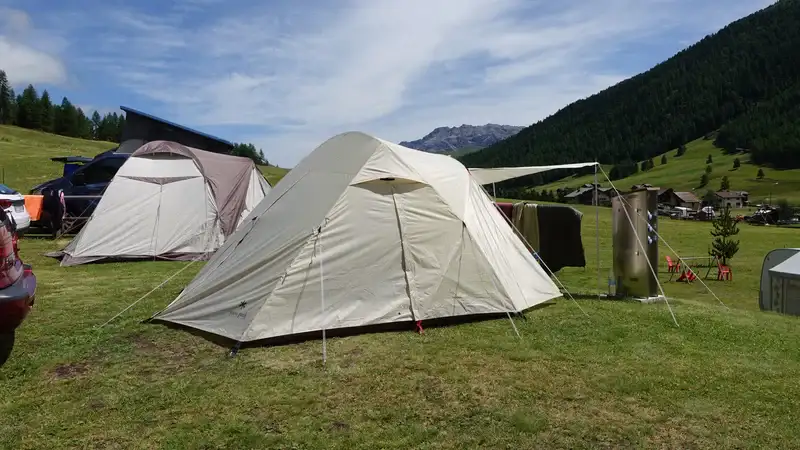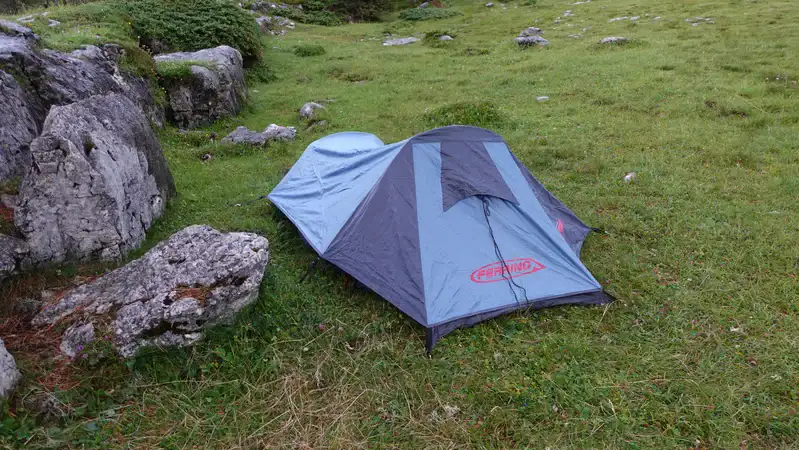It is a simple fact that condensation in a tent cannot be avoided. It can be reduced if a tent has vents and in favorable weather conditions, but this is a natural phenomenon that happens practically all the time.

Is there more condensation in a single wall tent than in a double wall tent?
I have seen some really wrong statements regarding single wall tents. One of them is that they tend to have less ventilation. This may be so in some tents, but I have seen many of the so-called double-layer tents with a massive fly yet without any roof or floor vent.
You can compare this with my Crua Duo tent shown in the picture above. I have just spent a night in it, and can tell you that such a statement simply makes no sense. This tent has three floor vents and two roof vents, and some of them are visible in the picture above.
In addition to this, it has a huge double-layer door which is deep inside the vestibule, so it is fully protected and you can keep it with mesh all the time as I did last night, see the picture below. This is the view from inside, and you can see the vestibule behind the inner door.

So it is not necessarily true that single-wall tent have more condensation. The issue is of a different nature.
So what is really a problem with single-wall tent condensation?
As always, it is best to compare, so here are some examples from my own experience.
Example one: In the past two weeks or so, I have been sleeping in three very different tents. One of them is my Snow Peak Alpha Breeze tent which I used in regular camps in the Alps. The picture below shows it in a camping below Forcola pass close to Livigno, Italian Alps.

This is a true double-layer type tent. The meaning is that it has an inner canopy which is all taffeta without any mesh areas, plus a massive fly.
But it has no less than four massive doors, and all of them are double-layer, with full size zippered mesh and full size zippered panels. In addition, it has two high vents as well.
The inner tent is also breathable, and I have never ever noticed any condensation inside. All vapor would go through the inner tent and condense on the underside of the fly.
So yes, you are reading correctly, there was a lot of condensation on the fly even in such a tent with excellent ventilation. This was a real issue with the vestibule which is angled, so when I want to get out, I get wet from it. Note also that the fly has its own separate vents (one is visible in the picture), but this cannot possibly prevent condensation.
Example two: When I was going up the mountains, I was carrying my solo Ferrino tent. So here you have an inner tent with mesh canopy, and a full cover fly.
The picture below shows it in the Dolomites, this is at an elevation above 2000 meters. You cannot see from the picture, but the ground was soaked with water, and it was raining, but I was dry inside.

However, the underside of the fly was as wet from condensation as the upper side from the rain. So in the morning when I was getting out of this low shelter, I was all wet, and the same was with my sleeping bag as well.
Example three: This is my mentioned Crua Duo Dome tent. Here you have one layer, there is no separate inner canopy. Only the door is double layer as you have seen above.
Can you guess what the real issue is?
Well, here is the answer. In the case of double-layer tents, condensation droplets form on the underside of the fly and they slide down the underside of the fly and go on the ground. Some droplets can go to the canopy, but here you have either mesh or taffeta, and this water will not go down on you and your sleeping bag.
However, in the case of a single-wall tent this is different. Some droplets may go directly on you, but in a well-designed tent with angled roof, this is rare. More importantly, the condensation will slide down and accumulate on the tent’s floor. This means, there is a chance that your sleeping equipment will get wet.
This morning when I woke up in my Crua Dome tent, I have seen just a few droplets on the tent’s floor. But the walls were wet of course. So this was not a big deal. But in a tent with several people this can be an issue.
Various sources give various numbers, but you can expect one person to produce around 150-200 grams of water condensate on the tent walls during a long night. So in a tent with five people, this would be up to one liter. Now imagine that a part of it ends up on the tent floor. You would have lots of wet stuff.
Is there condensation even in an empty tent?
Well, the short answer is yes. And this holds even for double-layer tents with the best design.
How do I know? I tested it, this is the answer.
Namely, I was moving from camping to camping, and I would move my bed from the car to the tent. But on one occasion, I decided I would keep sleeping in the car, I was lazy to move my bed, and use the tent as a living room during the day.
So in the morning, in such an empty but closed tent, I was able to see condensation on the inner side of the tent’s fly. This was my mentioned Snow Peak tent.
Why this was happening? I would say the answer is as follows. Assume a perfect situation with the tent that was completely dry in the evening. During the night there is a small temperature difference inside and outside. There may also be pressure variation during the night that will cause evaporation.
Now, there is always moisture in the ground occupied by the tent, and the fly is massive. So if vapor is created due to normal physical processes that take place overnight, one part of it will become trapped by the fly and it will condense on its underside.
Can you prevent condensation in a tent?
The simple answer is no, you cannot. But you might reduce it a bit if you know what you are doing and if you have the right tent. In the video below you can see a bit more:
Final thoughts
Single wall tents have their good sides. One of them is the fact that such a tent is fully closable, the roof and floor are all one single piece and you do not have drafts like in the double layer tents.
For this same reason, these tents may be quieter than double-layer tents. My Crua Duo Dome looks rock solid and there are no many pieces that would flap in the wind.
These tents can also be much better ventilated than double-layer tents, so disregard statements that claim the opposite, they generally make no sense.
But the fact is that the floor is directly connected with the fly and this is all sealed, so condensation on the underside of the roof may collect inside the tent on its floor. This is the main difference as compared with tents with a separate fly where such condensate will eventually end up on the ground.
This site is all about outdoors questions and answers and I add texts here on a regular basis, so bookmark it and keep as a reference. Read in particular my another related text about issues of leaking tents and condensation and about cooking in a tent.
Please use the comment box below in the case of questions or comments. Thank you for reading and have a nice day.
Leave a Reply